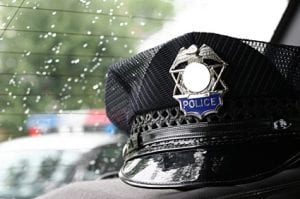Law Enforcement (Police) Funeral Service Rituals
 Law enforcement officers pledge to serve the public good and put their lives on the line daily. When they pass away, whether from circumstances in the line of duty or otherwise, their funerals should reflect honor and respect for their service and dedication.
Law enforcement officers pledge to serve the public good and put their lives on the line daily. When they pass away, whether from circumstances in the line of duty or otherwise, their funerals should reflect honor and respect for their service and dedication.
Perhaps you’ve witnessed one of these sad occasions, when an entire city can come to a standstill as a lengthy funeral procession, with full police escort, winds its way to the cemetery. Often such a funeral, especially for a line of duty death, will draw hundreds of uniformed officers from across the country. Their demonstration of honor, unity, and brotherhood is a sight never to be forgotten.
Perhaps you’ve witnessed one of these sad occasions, when an entire city can come to a standstill as a lengthy funeral procession, with full police escort, winds its way to the cemetery. Often such a funeral, especially for a line of duty death, will draw hundreds of uniformed officers from across the country. Their demonstration of honor, unity, and brotherhood is a sight never to be forgotten.
Departments and precincts often have unique traditions. For instance, the last radio call may include a mention of the officer’s background, the length of service, and circumstances of death, or it may consist of a few simple words, usually ending in, “Gone, but not forgotten.” We will focus on the many traditions that are common to the final goodbye for a fallen officer.
The information presented here is intended to be helpful to the officer’s family, friends, and department. Our purpose is to outline the funeral traditions for police and other law enforcement officers. (Law enforcement funerals are very similar to those for fallen firefighters and military personnel.) We’ll also list helpful resources that give more detail.
Police Funeral Customs: Where to Start
The starting point for planning an officer’s memorial service is the final wishes of the officer if they are known. Law enforcement departments that plan ahead for these occasions are wise to ask each officer to write down exactly what is desired at a memorial. These directives can include the designated department representative (e.g., a close friend in the department), choice of music, pallbearers, clergy, interment, and any other details the officer cares to designate.
With the officer’s directives taken into consideration, the family must be consulted. Their wishes outweigh the traditions of the department. It is vital that all options for honoring the fallen officer be presented to the survivors. They need to know not only what should be done (according to tradition), or what has always been done, but also what can be done to memorialize their loved one. It would be a sad situation for the family to learn, after the service, that they could have had the last radio call, but it wasn’t part of the department’s tradition.
The family can select only those elements of the service they wish to have included. For example, tradition might call for a three-volley salute to be offered at the cemetery; the family may decline because the sound of gunfire would be too traumatic. A “21 Bells” ceremony can be substituted. Again, survivors should understand the options presented but not be pressured into including any tradition.
Police Funeral Customs: Procedures Immediately After a Line of Duty Death
The family of the deceased must be notified before the press, always in person and (if possible) by the chief, the senior chaplain, and a designated department representative, who will become the family’s liaison. The family liaison will stay with the family until no longer needed.
When the family has been informed according to department policy, the period of mourning begins. The signs of mourning usually include shrouded badges (a piece of black tape or cloth placed horizontally across the badge) and flags lowered to half-staff. At the time of the funeral, black bunting may be displayed on the station and a cruiser.
Most departments assign a member to be the designated family liaison. It is especially important for one person to act as the family’s single point of contact with the department, and it is preferable that this person knows the family. Support should be made available to the survivors 24 hours a day, for as long as needed (up to a year after the funeral service). This support also includes transportation, especially immediately after the notification and at the funeral services.
Larger departments assign a Designated Department Representative or Survivor Action Officer, who has a team of officers working on various aspects of the funeral. For example, the Family Liaison Officer (and Chaplain, if applicable) discusses with the family the various options for a traditional funeral with military-style honors. The Chaplain or Funeral Officer makes the actual funeral arrangements, while the Traffic Unit Supervisor plans and coordinates the procession, and the Cemetery Officer handles the arrangements for interment or inurnment.
Other responsibilities that can be taken on by the department include assigning a 24/7 watch of the survivor’s home until after the funeral, shifts on casket watch who will stay with the body around the clock until the funeral, a color guard for the funeral, ushers for the service, and pallbearers to carry the casket or cremated remains. Be sure to ask the family if they would like to request certain people for these roles.
The department also can identify and arrange for a location that will accommodate a large funeral, make arrangements for the funeral procession and parking, and plan a luncheon or reception after the service. One or more of the department officials should write eulogies based on a close personal friendship with, or knowledge of, the deceased.
All of these decisions must take into consideration the final wishes of the officer and the preferences of the family.
Police Funeral Customs: Casket Watch and Honor Guard
Full military-style honors should be available to those heroes who die in the line of duty, starting with a casket watch. The duty of those who have the high honor of casket watch is to stand vigil during the wake or viewing. A team of two takes a 15–30-minute watch (beginning 30 minutes before the viewing and ending 30 minutes after), one at the head and one at the foot of the casket, facing each other. A second team relieves them every 15–30 minutes.
Many departments do not limit their casket watch to only the wake or viewing but stand guard 24/7 until the funeral.
The honor guard helps to plan and coordinate the ceremonial aspects and logistics of the funeral service. Those assigned to the honor guard include the casket watch, pallbearers, and color guard. All of these functions require up to 18 people, with experience or training needed for those responsible for standing guard, carrying the flags, folding the flag that draped the casket, and performing other duties.
Lt. Ken Baine of the Fairfax County, VA, police department, recommends a minimum of 21 honor guard members:
- 1 Funeral Commander
- 6 Pallbearers
- 6 Flag Team
- 8 Firing Party
Even a number that high isn’t enough, according to Lt. Baine, who has 40 honor guard members. “…what if one of your team members is on leave, sick, or too emotionally upset about the fallen officer to participate? To be on the safe side, you will need at least 30 team members for a line-of-duty funeral. If you are a small agency, have a plan with neighboring departments you can turn to if that time comes.” Source
Police Funeral Customs: Etiquette for Uniformed Members
An area of confusion for all of the uniformed services seems to be, “When do I remove my cover?” The answer is, when entering the funeral home or church unless you are a pallbearer or member of the honor guard or color guard. They may wear their hats at all times. Others put their hats on when they go back outside.
The other question is whether to salute the casket indoors with the hat on or off. Protocol seems to contradict itself here: don’t wear your hat indoors, but don’t salute unless you’re wearing your cover. A suggestion from Richard N. of the Orrville, OH, Fire Department addresses the problem:
I had been trained to remove my “cover” once inside. However, it is not proper to salute if you are not wearing a hat. In my experience, when you approach the casket of the fallen brother/sister, you stop, say a short prayer, put on your hat, come to attention with a sharp salute and then slowly lower the salute, turn and depart, removing your hat once you return to your seat or point of assembly.
Police Funeral Customs: Suggested Order of Events
The following suggested order of events would be appropriate for a formal, full-honors funeral.
First, the honor guard designee escorts the family to the staging area, meeting up with the casket. The chief is advised to start the ceremony. At this point, the honor guard (casket detail, pallbearers) performs its duties. They accompany the casket to its place of honor, and the Color Guard presents the colors.
After this ceremony, the funeral service itself begins. Following is an example of the order of events for a religious service:
- Invocation
- Prayer
- Opening remarks/greetings
- Special music
- Scripture reading/clergy remarks
- Speakers
- Mayor
- Local elected official from district
- State or Federal officials
- Family representative(s)
- Union representative
- Department representative’s friends
- Eulogy – Chief, dignitaries, and/or family
- Special music
- Presentations
- Closing remarks/prayer
- 21 Bells ceremony (also may be performed at cemetery)
- Bagpipes play (Amazing Grace, for example)
- Final Radio Call ceremony (also may be performed at cemetery)
- Color Guard retires the colors
- Bagpipes play as the Pallbearers remove the casket
- Dismissal instructions
The honor guard’s duties continue during the procession to the cemetery and the interment, with each department following its own procedures. The procession for a LODD may include hundreds of cars, and both traffic and parking control are necessary. At the interment, honors may include Last Radio Call, three-volley salute (or 21 bells), flyover, flag folding, playing of Taps, bagpipes, and a dove release.
Police Funeral Customs: Venue
A line of duty death is a tragedy that brings officers, dignitaries, and mourners from surrounding cities, states, and (sometimes) even nations. The venue for the funeral should be large enough to accommodate several thousand mourners and have a parking lot where the procession to the cemetery can be staged. Options can include a school auditorium, a civic auditorium, or a large church.
Contributor: Jenny Mertes

